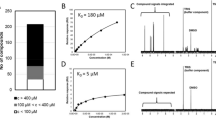Abstract
The versatility of NMR and its broad applicability to several stages in the drug discovery process is well known and generally considered one of the major strengths of NMR (Pellecchia et al., Nature Rev Drug Discov 1:211–219, 2002; Stockman and Dalvit, Prog Nucl Magn Reson Spectrosc 41:187–231, 2002; Lepre et al., Comb Chem High throughput screen 5:583–590, 2002; Wyss et al., Curr Opin Drug Discov Devel 5:630–647, 2002; Jahnke and Widmer, Cell Mol Life Sci 61:580–599, 2004; Huth et al., Methods Enzymol 394:549–571, 2005b; Klages et al., Mol Biosyst 2:318–332, 2006; Takeuchi and Wagner, Curr Opin Struct Biol 16:109–117, 2006; Zartler and Shapiro, Curr Pharm Des 12:3963–3972, 2006). Indeed, NMR is the only biophysical technique which can detect and quantify molecular interactions, and at the same time provide detailed structural information with atomic level resolution. NMR should therefore be ideally suited and widely requested as a tool for drug discovery research, and numerous examples of drug discovery projects which have substantially benefited from NMR contributions or were even driven by NMR have been described in the literature. However, not all pharmaceutical companies have rigorously implemented NMR as integral tool of their research processes. Some companies invest with limited resources, and others do not use biomolecular NMR at all. This discrepancy in assessing the value of a technology is striking, and calls for clarification—under which circumstances can NMR provide added value to the drug discovery process? What kind of contributions can NMR make, and how is it implemented and integrated for maximum impact? This perspectives article suggests key areas of impact for NMR, and a model of integrating NMR with other technologies to realize synergies and maximize their value for drug discovery.

Similar content being viewed by others
References
Becattini B, Pellecchia M (2006) SAR by ILOEs: an NMR-based approach to reverse chemical genetics. Chemistry 12:2658–2662
Coles M, Heller M, Kessler H (2003) NMR-based screening technologies. Drug Discov Today 8:803–810
Dalvit C, Caronni D, Mongelli N, Veronesi M, Vulpetti A (2006) NMR-based quality control approach for the identification of false positives and false negatives in high throughput screening. Curr Drug Discov Technol 3:115–124
Hajduk PJ, Greer J (2007) A decade of fragment-based drug design: strategic advances and lessons learned. Nat Rev Drug Discov 6:211–219
Hajduk PJ, Mack JC, Olejniczak ET, Park C, Dandliker PJ, Beutel BA (2004) SOS-NMR: a saturation transfer NMR-based method for determining the structures of protein–ligand complexes. J Am Chem Soc 126:2390–2398
Hubbard RE, Chen I, Davis B (2007) Informatics and modeling challenges in fragment-based drug discovery. Curr Opin Drug Discov Devel 10:289–297
Huth JR, Mendoza R, Olejniczak ET, Johnson RW, Cothron DA, Liu Y, Lerner CG, Chen J, Hajduk PJ (2005a) ALARM NMR: a rapid and robust experimental method to detect reactive false positives in biochemical screens. J Am Chem Soc 127:217–224
Huth JR, Sun C, Sauer DR, Hajduk PJ (2005b) Utilization of NMR-derived fragment leads in drug design. Methods Enzymol 394:549–571
Jahnke W (2002) Spin labels as a tool to identify and characterize protein–ligand interactions by NMR spectroscopy. Chembiochem 3:167–173
Jahnke W, Erlanson DA, (eds) (2006) Fragment-based approaches in drug discovery. Methods and principles in medicinal chemistry. Wiley-VCH
Jahnke W, Widmer H (2004) Protein NMR in biomedical research. Cell Mol Life Sci 61:580–599
Klages J, Coles M, Kessler H (2006) NMR-based screening: a powerful tool in fragment-based drug discovery. Mol Biosyst 2:318–332
Lepre CA, Peng J, Fejzo J, Abdul-Manan N, Pocas J, Jacobs M, Xie X, Moore JM (2002) Applications of SHAPES screening in drug discovery. Comb Chem High throughput screen 5:583–590
Lundqvist T (2005) The devil is still in the details—driving early drug discovery forward with biophysical experimental methods. Curr Opin Drug Discov Devel 8:513–519
Oltersdorf T, Elmore SW, Shoemaker AR, Armstrong RC, Augeri DJ, Belli BA, Bruncko M, Deckwerth TL, Dinges J, Hajduk PJ, Joseph MK, Kitada S, Korsmeyer SJ, Kunzer AR, Letai A, Li C, Mitten MJ, Nettesheim DG, Ng S, Nimmer PM, O’Connor JM, Oleksijew A, Petros AM, Reed JC, Shen W, Tahir SK, Thompson CB, Tomaselli KJ, Wang B, Wendt MD, Zhang H, Fesik SW, Rosenberg SH (2005) An inhibitor of Bcl-2 family proteins induces regression of solid tumours. Nature 435:677–681
Pellecchia M, Sem DS, Wüthrich K (2002) NMR in drug discovery. Nature Rev Drug Discov 1:211–219
Sanchez-Pedregal VM, Reese M, Meiler J, Blommers MJ, Griesinger C, Carlomagno T (2005) The INPHARMA method: protein-mediated interligand NOEs for pharmacophore mapping. Angew Chem Int Ed 44:4172–4175
Shuker SB, Hajduk PJ, Meadows RP, Fesik SW (1996) Discovering high-affinity ligands for proteins: SAR by NMR. Science (Washington, DC) 274:1531–1534
Stockman BJ, Dalvit C (2002) NMR screening techniques in drug discovery and drug design. Prog Nucl Magn Reson Spectrosc 41:187–231
Takeuchi K, Wagner G (2006) NMR studies of protein interactions. Curr Opin Struct Biol 16:109–117
Vazquez J, Tautz L, Ryan JJ, Vuori K, Mustelin T, Pellecchia M (2007) Development of molecular probes for second-site screening and design of protein tyrosine phosphatase inhibitors. J Med Chem 50:2137–2143
Wyss DF, McCoy MA, Senior MM (2002) NMR-based approaches for lead discovery. Curr Opin Drug Discov Devel 5:630–647
Zartler ER, Shapiro MJ (2006) Protein NMR-based screening in drug discovery. Curr Pharm Des 12:3963–3972
Acknowledgments
I wish to thank my Novartis colleages, Hans Widmer, Sandra Jacob, Marcel Blommers, Cesar Fernandez, and Jean-Michel Rondeau, for their valuable comments and suggestions.
Author information
Authors and Affiliations
Corresponding author
Rights and permissions
About this article
Cite this article
Jahnke, W. Perspectives of biomolecular NMR in drug discovery: the blessing and curse of versatility. J Biomol NMR 39, 87–90 (2007). https://doi.org/10.1007/s10858-007-9183-5
Received:
Accepted:
Published:
Issue Date:
DOI: https://doi.org/10.1007/s10858-007-9183-5



